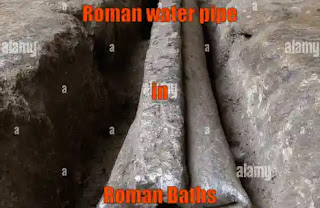Baths in the Roman era
introduction
The Roman baths (Balneae and Thermae) are among the most prominent landmarks of Roman civilization, reflecting the Romans' interest in personal hygiene and public health, as well as their social and cultural role in the lives of citizens.
Ancient Roman baths were a meeting place for citizens of the Roman Empire; they were used for bathing, socializing, and a variety of recreational and health-related activities. Many of these baths still stand today in good condition, while only ruins of others have been found.
What are ancient Roman baths?
Ancient Roman baths are known as public bathing facilities. Many of these baths have been well preserved to this day, most notably the Roman baths located in England, the United Kingdom. These baths were not limited to one location in the Roman Empire, but were found in many countries.
The origin and development of baths
The concept of baths in Rome began as simple versions of Greek baths, but the Romans greatly expanded them, transforming them into massive public facilities containing numerous halls and amenities. Initially, baths were private and used only by the wealthy, but over time they became public and open to all segments of society, eventually becoming an essential part of daily life.
Within the canonical architecture, Vitruvius' treatises are the first treatises known. besides discussing the intellectual and cultural formation, interests, and sensitivity of the architect, or the "sacred" triad of architecture - venustas, firmitas, and utilitas (beauty, solidity, and functionality) - the treatise describes a design method, a sort of manual for Roman construction at the period. Complex and sophisticated, Roman architecture presented a variety of buildings with several functions. Among them were thermal baths, which did not ran away Vitruvian prescriptions.
Water was collected through natural sources and aqueducts ensuring the necessary supply for the complex thermal baths, examples of Roman ingenuity that still impress contemporaries and pay attention them. In general, thermal baths had indoor pools and used steam to heat the environment.
Components of the Roman bath
Roman baths consisted of several rooms arranged sequentially to provide a complete experience:
lobby
The atrium is a hallway that existed in ancient Roman baths. It was used as a passageway for entry and exit, and sometimes contained seating for waiting.
gyms
Exercise halls were available in many ancient Roman baths alongside other facilities, indicating that they were also places for entertainment, not just bathing.
Caldarium
The caldarium in the ancient Roman baths contained a heated pool and a separate basin on a stand, which was in a heated room.
pool:
Ancient Roman baths contained large, cool pools that allowed several people to swim together. It's worth noting that the pools were open in Rome, but closed in North Africa.
Sweat rooms:
Ancient baths in Rome included sweat rooms, which were characterized by high temperatures inside, either dry or wet rooms along with high heat.
Massage and oiling room:
As its name suggests, this room was used in ancient Roman baths to provide body anointing services with oils and ointments, as well as massage and skin scraping services to remove dirt.
arenas :
Many physical activities and games were held in what were called arenas inside the ancient Roman baths, among these activities was wrestling. Columns surrounded these arenas, which were either enclosed or open.
Apodyterium:
It's the dressing room.
Tepidarium:
It's the warm water room.
Caldarium:
It is a hot water and steam room.
Frigidarium:
It's the cold water room.
Sudatorium:
It's a sweat room or sauna.
Some baths also included libraries, gardens, gyms, and lecture halls, making them integrated cultural and entertainment centers.
Technologies used
The Romans used advanced engineering techniques in building baths, most notably the hypocaust system, whereby air and water were heated by underground furnaces, providing adequate heat for the rooms and water. These systems were evidence of the great scientific and engineering progress achieved by the Romans.
Did ancient Roman baths use any hydraulic elements?
Indeed,
ancient Roman baths used many hydraulic elements, according to a study
of ancient Roman baths between architectural system and function. Among
these were: water tanks placed in elevated locations to facilitate
distribution processes; they were the element responsible for providing the water drawn from the main aqueduct.
 |
| water Roman pip in Roman bath |
Ancient Roman baths used a network of conduits made of cylindrical and semi-cylindrical pipes to distribute water. These pipes were made of wood, metal, or clay, and were often made of lead. The pool was also one of the hydraulic elements in these baths.
Social and cultural dimension
Baths were not just places for cleanliness; they were daily meeting places for people of all classes. Men and women would go there at separate times, chatting, holding meetings, and sometimes even discussing political affairs. Some baths were also used as a place to relax after a day's work or to exercise.
The most famous Roman baths
Among the most famous Roman baths whose remains still exist today:
Roman Baths at Herculaneum:
The Roman city of Herculaneum contains two of the finest Roman baths in the world. This city was once a coastal town with a population of 4,000 at its peak.
The ancient Roman Baths of Diocletian:
The ancient Roman Baths of Diocletian could accommodate up to 3,000 people, meaning they had a large area, and these baths had spacious rooms.
Ancient Roman Imperial Baths of Trier:
Many experts believe that Trier had the largest complex of ancient Roman baths outside of Rome, and many of the walls of the ancient Roman Imperial Baths of Trier still stand today.
Roman Baths of Conimbriga:
· Ancient Roman baths were found in the city of Conimbriga. These baths were distinguished by their heating systems, and they also contained decorative mosaics, a hot bath, and several other facilities.
Ancient Roman Baths of Lyon:
Experts believe that the ancient Roman baths of Lyon were built during the 2nd or 3rd century AD, and served a city that served as an important regional capital for the emperor.
Roman Baths at Welwyn:
· The Roman Baths at Welwyn date back to the 3rd century AD, making them over 1,700 years old at the time. These baths were part of one of the larger Roman villas.
Baths of Caracalla
it is one of the largest public baths in Rome.
Baths of Diocletian
The Baths of Bath in England:
built in the Roman style.
conclusion
Roman baths embody an advanced aspect of a civilization that cared for human well-being in multiple aspects: physical, social, and cultural. These facilities remain a testament to the sophistication of Roman infrastructure and engineering, and to Roman society's awareness of the importance of cleanliness and public health.













